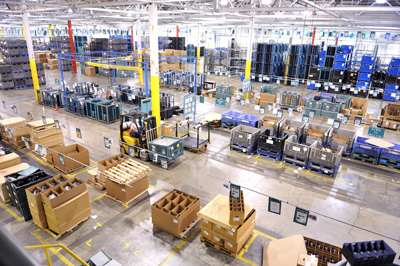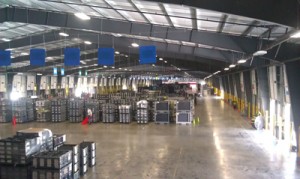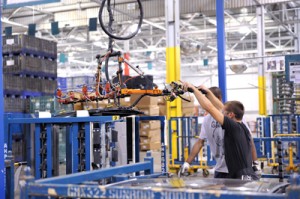The design of logistics networks can have a decisive effect on their performance and efficiency, but it is necessary for manufacturer and logistics providers to reengineer them as often as possible to gain the most efficiency.

For manufacturers, the total effect of these decisions is critical in determining a vehicle programme’s overall logistics costs. Some carmakers and suppliers choose to keep this engineering in-house. In North America, for example, Toyota has recently decided to centralise logistics engineering for milkrun and direct deliveries. This activity had formerly been the responsibility of plants, which in turn outsourced it to providers.
But while the question over outsourcing and in-sourcing will always remain, logistics engineering is an increasingly important activity for third party providers. For many, doing the right engineering is essential to winning business and operating at a profit.
Reducing and refining
US-based Penske Logistics runs logistics for a number of major carmakers and tier one suppliers including Ford, General Motors, BMW and Delphi. Amy Ilyes is the company’s vice-president of logistics engineering. “There is some kind of logistics engineering input with every single customer we work with,” she explains. “My team works alongside our sales teams to design solutions for new customers or programmes, with our operations teams to assist with continuous improvement activities. We also work jointly with our technology team to develop the tools we use in our logistics engineering processes.”
For a new programme, says Ilyes, this process typically starts by obtaining a comprehensive set of data from the customer. “We collect information on shipping volumes, the size and weight of the part, the type of packaging, and other operational data, such as the required delivery window times and whether they will be using returnable packaging.”
If Penske is bidding to take over an existing programme, Ilyes’ team will also ask for details of existing routes and financial information including current carrier and crossdock rates, and the customer’s internal cost of capital. The latter, she explains, helps in the calculation of the cost of changes to inventory levels. “Most OEM customers give us good data, although there may be a few gaps,” she says.
The team’s next step is to analyse the data, to check that it is sound and to calculate the achievable cube utilisation. “Getting to that point takes 30-40% of the time required on a logistics engineering project,” says Ilyes. “But it allows us to develop a baseline cost for running the flow. Ideally, we like to check our estimates against actual financial statements for existing routes, and we usually find we are within 3-5%, which we feel is an acceptable range.”
Once a logistics provider has baseline data in place, it can work its own magic to identify design changes and refinements that might deliver cost reductions or

At Ryder, Tom Kroswek, senior director of supply chain excellence in automotive, summarises the basic challenge of the logistics engineering process. “It’s all about finding density in the network,” he says. “You want density in the trucks, you want density in shipments, and density in supplier locations. When you have that, it’s much easier to run an efficient network and meet your customer’s inventory goals, and those goals are getting tighter all the time, with our customers cutting their targets from a week to less than two days or even just a few hours.”
Trucking costs are often the major part of a logistics operation. “The majority of the cost is in vehicles, so improving vehicle utilisation is always a priority,” says Michael Martin, vice-president of business development for automotive at DHL UK. “If you can reduce vehicle use by 10%, that typically gives you 2-3% overall costs savings.”
However, there are many other factors that define the overall performance of a logistics flow, he adds. “You need to see vehicles being made and understand the culture of the customer. OEMs have different techniques and methods, and the age of the facility is important. Line-side space is always at a premium, and we want to make sure that activity at the line side is all about value add.”
To this end, says Martin, DHL offers its customers a range of services, including the redesign of packaging and preassembly activities prior to line-side delivery.
Higher risks mean more engineering
Supply chain risk and demand volatility have had increasing impact on the automotive business in recent years. However, Amy Ilyes notes that OEM customers typically have a high confidence that the volumes and specifications they put out to tender are the ones they will eventually use, which allows Penske to engineer for exactly those flows. Some tier supplier customers are less confident of the final shape of new flow. Ilyes’ team may also run sensitivity analyses on their models to check how much costs would be affected by changes in final requirements. If necessary, this approach allows them to propose adjustments to the logistics network and then to the customer.
Also at Ryder, Jeff Kosloski, group director for supply chain solutions in automotive, points to the integration of risk calculations into the logistics engineering process as one of the most significant changes of recent years. “The base plan is always for average volumes – now we are trying to make our networks more dynamic, so they can cope better with disruptions or volume fluctuations,” he says.
However sophisticated the models that companies use to generate flow designs, they must undergo a good deal of checking before implementation. “You might find, for example, that certain parts can only be handled at certain dock doors,” says Ilyes. “So it doesn’t make sense to load those parts with others that need to go to a different door.”
Typically, the customer will also want to take a hard look at the proposed design before signing off on it. “Our customers are usually highly sophisticated in their logistics processes, so they are very interested in the details of the solutions we propose,” she continues.
"You want density in the trucks, you want density in shipments, and density in supplier locations. When you have that, it’s much easier to run an efficient network and meet your customer’s inventory goals, and those goals are getting tighter all the time, with our customers cutting their targets from a week to less than two days or even just a few hours" - Tom Kroswek, Ryder
Ryder’s Kroswek also points out that the location of existing supply chain infrastructure does limit the freedom that logistics providers have to optimise flow designs. “A lot of the OEMs did this kind of analysis several years ago, and they invested to put crossdocks and other facilities in place,” he says. “Today, even if your analysis suggests that an alternative location would be better, it’s pretty hard to create the business case for moving a facility.”
At DHL, Martin cites changes in the aftermarket space as one area where networks have recently changed shape. “A lot of our OEM customers are coming under increasing pressure in the aftermarket from independent factors. In response they are looking to improve the responsiveness of their service, and many are moving from national to regional distribution centres. We have set up new sites in response to that.”
More frequent changes
Logistics players agree that there are still significant gains to be captured in engineering today’s supply chains. “Even working with quite sophisticated OEMs, we can often find savings of 3-5% by refining the design of a flow,” says Penske’s Ilyes.

Carter’s pricing system passes the cost savings from route improvements directly back to the customers, and the company is closely involved in its customers’ transport budget processes. “We have one customer with an annual cost saving target of 7.5%,” DeBoer notes.
While most of Carter’s shared milkrun customers have been optimising flows for five years or more, there are new potential customers too. “Key target customers for us are tier ones that are still using dedicated logistics networks. If we can persuade them to move to a shared model, we can usually show them significant transportation savings.”
It is an idea that is becoming gradually easier to sell, he notes. “We know companies that were steadfast about using dedicated routes, and they are now coming to us asking us if we can put together a shared network for them. We are even beginning to see some momentum for shared networks from OEMs that traditionally would not share a truck with their competition.”
Ryder’s Kosloski also sees growing interest from customers in shared networks. “There are areas where OEMs don’t need to share their networks, but there are others where it looks increasingly beneficial to do so, especially where they don’t have the density to run efficient networks alone,” he says. “There’s been a lot of resistance to the idea of sharing, but that is slowly being overcome.”
Keeping it in trim
Logistics engineering doesn’t stop when the trucks start rolling. Providers emphasise the need to continually review and refine their designs once an operation starts. The approach they use to do this varies depending on the company, the customer and the kind of business. “Obviously, our operations teams are making small tweaks and changes every day, but for our major customers we typically take a full look at the logistics engineering design on a quarterly basis, to check that the assumptions we used originally are still valid, and that the flow is performing as it should,” says Amy Ilyes. “For smaller customers, we constantly measure the health of the network, and ask our operations teams to spot trends, like falling utilisation, that might indicate we need to do a deeper review.”
At Ryder, Kosloski sees more frequent logistics re-designs as a significant recent trend. “At one time, we might have left a network to run for a quarter or six

Fast data analysis helps, he adds, including the speed and visibility that modern IT systems provide. “I can look back to a time when it took a month to plan a route for a single plant,” recalls Kosloski. “Now we are routinely talking about weekly updates to a route design.”
According to Carter’s Richard DeBoer, reviewing and adjusting on-going business is a critical part of his company’s offering to its customers. “We have a team of seven analysts, all from financial or supply chain backgrounds, and they are an extension of our customers’ supply chain and logistics’ departments,” he says. “We have information on daily cubes from our customer’s suppliers so we can evaluate the efficiencies of our 400 daily routes.”
The objective, says DeBoer, is a cube utilisation of 80%, which Carter’s studies have shown is the level needed to cope with typical daily fluctuations. The company has even found that being higher than this level can actually make the supply chain less flexible. “If we start to drift away from 80% in either direction, we look to see if we can remove one supplier, or add another in order to get closer to our target,” he says.
If such a change makes sense from an utilisation point of view, the team then has to check that it also works financially and operationally, without, for example, adding too much truck distance, or affecting customers’ delivery schedules. To conduct its optimisations, Carter uses a number of third-party software for jobs like route planning and scheduling. These tools provide a useful basis, but they also need considerable manual intervention and checking, notes DeBoer.
"A lot of our OEM customers are coming under increasing pressure in the aftermarket from independent factors. In response they are looking to improve the responsiveness of their service, and many are moving from national to regional distribution centres" - Michael Martin, DHL
“When the system generates a route, we have to check that it isn’t going to create driver hours-of-service issues, and we also have to look at such things like border crossing time at the US-Canada border,” he says. “In addition, because returnable packaging is a key element of our milkrun system, it is critical we account for sufficient dock door times to unload returnables and load parts.”
At Ryder, Kosloski agrees that the increasingly global nature of automotive supply chains is another area that requires logistics engineering input. “As our customers have become more global, we’ve had to develop tools to assist us with the planning and operation of international networks,” he says.

Logistics providers are looking to improve their logistics engineering, including doing more of what companies are already pretty good at. At Penske, for example, Amy Ilyes notes that as computing power continues to increase, it will be able to evaluate more possible flow designs and to conduct re-evaluations more frequently, allowing companies to find and refine networks with greater frequency and ease.
At Carter Express, where the challenge is getting the highest possible level of performance from a shared network, Richard DeBoer cites data standardisation as a challenge. “Everyone has different standards for their data and the way they want to run their networks,” he says. “If they used a more common approach, it would greatly assist us in putting networks together.”
Ryder’s Kosloski says that improving the quality and robustness of data is important to network design. “We get lots of data from our customers today, and they are giving us more and more, but the real challenge is ensuring that the data is up to date and maintained.”
Other benefits will also come from the availability of novel data sources. DHL, for example, is investing in vehicle telematics to monitor locations and driver behaviour, with a view to encouraging more efficient driving practices and lower fuel costs. Ilyes notes that Penske is already beginning to use traffic congestion data when it compares different truck route options. At the moment, the cost of licensing that data is quite high, she notes. “But it is getting cheaper all the time.”


































